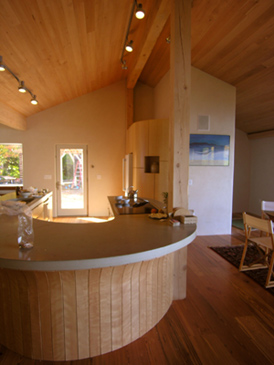LEED Platinum Certified Renovation
The Bindley home is not a typical ranch house on a lake as it may appear at first glance. It is a super efficient, net-zero energy, Leadership in Efficiency and
Environmental Design (LEED) Platinum certified homethat was designed as an experiment to stretch the bounds of energy efficiency and green design. This experiment demonstrates what is possible when using existing state-of-the-art technology to achieve, among other things, the elimination of fossil fuels as a source of heat, light or domestic hot water in a house. This web site describes some of the green design features and products used.
HEAT CONSERVATION
R-73 Roof, R-52 Wall, R-42 Basement Wall, R-25 Basement Slab
In central New Hampshire to use solar energy to serve all of the home’s energy loads it was imperative to reduce these loads to absolute minimum levels first. The heating energy required is reduced by superinsulation. The existing wall and roof interiors were removed and foam insulation was sprayed into the wall and roof cavities. In the basement, a new wall was framed 4 inches inside the foundation walls and 7 inches of foam was sprayed there and at the perimeter of the frame floor. Four inches of rigid foam were added over the basement floor slab.Outside existing wall and roof sheathing plywood edges were sealed with peel-and-stick tape as the primary air barrier. 6-1/2 inch foam panels were then added to the exterior of the house. The resulting insulating values are as follows:foundation – R-42, walls – R-52, and roof – R-73. These values are 2-3 times that of the typical new home.
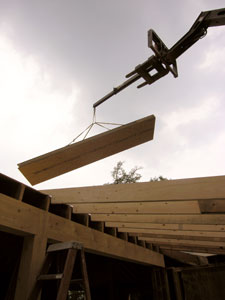
3/100 ACH Natural Air Tightening Package
The air tightness of the existing home was tested with a calibrated instrument called a blower door http://www.energyconservatory.com/products/products1.htm.
Then as the air barrier was implemented the house was retested to verify the integrity of the air tightness installation. Finally, the house was pressurized with the blower door and a theatrical fog machine was used to visually locate remaining leakage areas. The result is that the air leakage has been reduced tenfold. Much of the remaining air leakage is in the sliding glass doors, which are difficult to make airtight.
R-5 Exterior Windows and Doors
The windows and glass doors are Canadian products http://www.thermotechfiberglass.com/
with hollow fiberglass frames filled with foam insulation, triple glass with two low emissivity coatings, and low conductivity gas fill. Their insulating value is just over 5, which is 60% better than a typical modern wood double glazed window. Portable foam-filled insulation panels will be built to cover the large glass openings to reduce heat loss at night.
HEATING
Closed Loop Ground Source Heat Pump – Warmboard Radiant Sub-floor
Because the solar panels generate electricity, an electrically-powered ground source heat pump http://www.waterfurnace.com/ can supply heat to the house. Using this input of electrical energy, heat is moved from the relatively temperature-stable ground into the home. Three 220-foot-deep vertical closed polyethylene piping loops provide connection to the ground. Then the heat pump concentrates the energy to heat a tank of water to 95°F. This water is then circulated through radiant heat tubing http://www.warmboard.com/under the floors when any thermostat calls for heat. The low water temperature allows the heat pump to operate in a highly efficient range, in which three or more units of energy are delivered to the house as heat for every unit of electrical energy consumed by the heat pump. The annual heating energy consumption for the house is estimated to be about 2,500 kWh, which would cost about $400/year if purchased from the grid.
Ventilation System – Heat Recovery Ventilator
The house has a mechanical ventilation system to provide superb air quality. A heat recovery ventilator http://www.renewaire.com/ removes stale air from the bathrooms and supplies fresh air to the bedrooms.Inside the ventilator, heat from the warm exhaust air is transferred to the incoming cold outdoor air, preheating it and greatly reducing the energy demand of providing fresh air to the house. When the house is unoccupied, the ventilator can be switched off to save energy.
ELECTRICITY
LED Light Bulbs
Light Emitting Diode (LED) light bulbs are used exclusively in the house, including the world record holder in efficiency for watts per lumen of light; the LLF LED can. (http://www.buildinggreen.com/auth/article.cfm/2008/2/3/LED-Lamp-Sets-Efficiency-Record/ and http://www.cree.com/) LED bulbs are twice as efficient as compact florescent bulbs and last 5 times as long. Furthermore, they contain no mercury as do Compact Fluorescent Lights (CFLs). The only downside to LED bulbs is that they are much more expensive than CFLs. The LLF cans mentioned above are $88 a can.
Solar Electric Panels
An array of thirty-six Sunpower solar electric panels http://www.sunpowercorp.com/totaling 7.5 kilowatts (kW) is mounted on the roof. The direct current generated by these panels goes to two inverters that transform the power to normal AC household current. On a sunny day, the panels produce an excess of electricity and any surplus energy is exported to the utility grid so that it may serve others’ needs. This turns the electric meter backwards, in a process called net metering. At night, energy needed by the house flows back from the grid. The utility-tied system uses the grid as the storage medium, as opposed to off-grid homes, which use batteries to store surplus energy for nighttime or cloudy day loads. And often back-up generators are needed for off-grid homes to bridge the gap. The grid-tied systems are simpler and less costly, require less maintenance, and ensure that all energy generated is used somewhere.
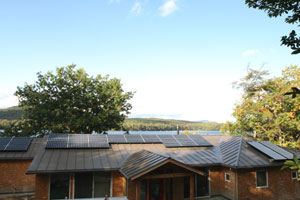
The solar systems on the Bindley house are slightly shaded by trees to the south, and are therefore expected to have somewhat diminished output, making the zero net energy objective even more challenging. Nonetheless, the system is expected to generate over 8,000 kilowatt-hours (kWh) annually. With careful use of energy by the occupants, this should enable the Bindley home to achieve zero annual net energy performance.
WATER USE
Solar Thermal Domestic Hot Water System
Domestic hot water is supplied by two 40 sq ft solar thermal panels that heat a total of 200 gallons in two separate storage tanks. Electric resistance heat provides back-up.
Low-Flow Toilets and Fixtures for 3½ Baths
Each bathroom has a Toto Auqia II dual flush toilet. These toilets have a .9 gallon per flush option that is significantly more efficient than the standard energy star 1.6 gallon per flush. (http://www.toto.com/productpage.asp?PID=1064)
Recirculation Plumbing Lines
We installed a recirculation hot water system to allow sinks far from the hot water tank to pump the room temperature water in their hot water lines back into the water heater while waiting for hot water from the tank. This system conserves heat in the hot water pipes and keeps users from wasting water down the drain while waiting for hot water in the faucet. (http://www.buildinggreen.com/auth/article.cfm/1995/3/1/Hot-Water-on-Demand-And-No-Energy-Penalty/)
The Bindley home employs .5 gallon per minute (gpm) faucet aerators and 1.5 gpm flow restrictors on the showers in order to reduce hot water used on site.
GREEN MATERIALS
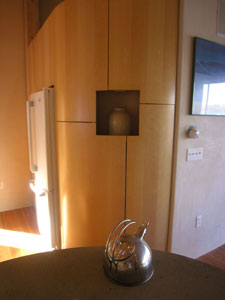
Forest Stewardship Council (FSC) Materials
We’ve made a concerted effort to buy wood from local and sustainable sources; especially wood that has been certified by the Forest Stewardship Council. This ensures that the wood is harvested from a forest that has been properly managed by loggers who use sustainable practices that don’t hurt the environment or violate labor practices. Below is a list of some of these woods. http://www.fscus.org/
- Forest Stewardship Council Certified (FSC) cedar siding
- FSC hemlock timberframe
- FSC birch kitchen and built-in
- FSC maple closets and built-ins
- FSC pine trim
- FSC wide board antique pine/oak flooring
- Local eastern white pine flooring and siding
- FSC garape deck for porch floors
- FSC heart of pine stairs
- Salvage maple handrails
- FSC SPF framing lumber and interior partitions
Recycling and Salvage
Salvage softwood doors and salvage door hardware were used for the entire interior door schedule. The bathrooms were tiled with an American-made recycled glass tile.
Recycling of Construction Waste
We used Waste Management to recycle up to 90% of our construction waste.They document the rate at which they recycle our construction waste and give us detailed reports. Most demolition and construction waste can be recycled. The cost is often not more than what it would cost to dump everything in the land fill.
Local Stone
Local stone was used throughout the site. In the interior of the home, the granite slab entry was quarried in the region. On the home’s exterior, local granite and fieldstone were used for various landscaping elements.

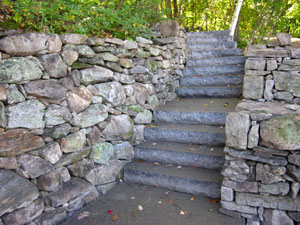
American Clay Plaster
American Clay plaster http://www.americanclay.com/ was used for the walls and ceilings.This plaster has a lower embodied energy (the energy required to produce it) than all other wall treatments.It is made of postindustrial products, is recyclable, and it contributes to the negative ion charge inside the home. High charges of negative ions in the air increase the production of serotonin, reduce stress,and help to filter pollen and dust. Fresh country air has a negative charge of 2000 to 4000 negative ions per cubic centimeter. Air in an office is usually below 600 negative ions per cubic centimeter. American Clay has the capacity to produce negatively charged particles in the home.
Low Volatile Organic Compound (VOC) Paints and Stains
An effort was made to use low-VOC paints http://www.afmsafecoat.com/, sealers and binders in all aspects of construction to improve indoor air quality for installers and home owner. The salvage interior doors were stripped of old paint and oiled with a low-VOC finish.
Green Roof on Garage
The Bindley home enjoys a two-car garage with a green roof to reduce run-off from rain into the lake. A Hydrotech 160 mil waterproofing system was used as a barrier between the growing roof and the garage structure. The low-bush blueberries on the roof are growing in a medium geared both toward drainage and sustenance for the plants. (http://www.rooflite.us/?rooflite-intensive)

